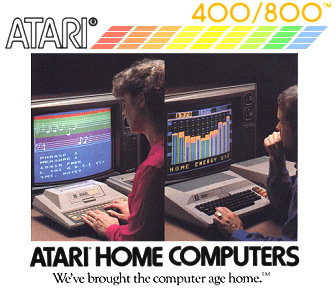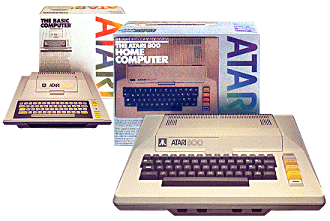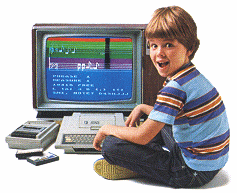|

1978 - The Atari 400 and 800
were driven by the new CEO of Atari, Ray Kassar, who wanted to compete
with Apple in the computer market. At this time, development work
was being put into the next generation video game machine to supersede
the 2600, but that was all shelved, and Atari turned its resources to
the computer market.
The new computer division based the new
machines around the powerful MOS 6502 CPU (running at a blistering
1.79Mhz), a favourite with home computer manufacturers in the late 70's
and early 80's (also popular in gaming systems, such as the Atari Lynx).
Originally codenamed "OZ", Atari renamed the 2 systems after female
Atari employees (as was the tradition!); the 400 became known as project
"Candy" and the 800 became known as project "Colleen".

The Atari 400 and 800 systems were some of
the most powerful home computers of the day, and they became famous for
their "high resolution" graphics capabilities. Initially,
the machines could only display 128 colours, but this was updated
shortly after to an incredible 256 colours using the updated GTIA
(General Television Interface Adapter) processor. Sound was also
impressive, with the Atari "Pokey" responsible for the 4-Channel
acoustics.

The 400 employed a "membrane" keyboard,
which was liquid-proof and aimed at schools, and families with young
children. The 800 was designed for the professional, and was built
with a fantastic keyboard, with the keys employing an almost tactile
response similar to using an actual typewriter. Both machines were
designed to be user friendly, and Atari designed a unique cartridge
system similar to that used on its video game console, the 2600.
Software could come on a plastic cartridge and simply slotted into the
computer, which when switched on, appeared on the screen instantly -
this must have had huge appeal, especially considering the fear
computers held in those early days.
Both machines were extremely well built,
with the entire inside of the system made of die-cast metal, their
weight alone made you feel you had actually spent your money wisely!
At over $1000.00 for the Atari 800, and just over $400.00 for the Atari
400, these machines were not low-cost devices. In Europe, their
pricing was even more prohibitive, and it wasn't until 1983/84 that they
began selling in any reasonable number.

But as the prices went down, the competition
went up, and the Atari 400 and 800 languished in the market-place, with
no sign of a technology upgrade, or even a case redesign. It
wasn't until late 1982 that the XL range was being readied for launch,
but was it too little too late?
The legacy of the Atari 400 and 800 lives
on, and they were Atari's' first foray into the computer market.
This first 8-Bit line of computers spawned 3 generations and still work
flawlessly today. In fact, of all the Atari computers, these were
definitely the most solidly built machines to ever leave the Atari
factories.
|